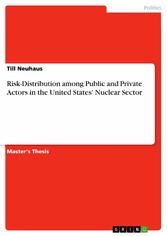Risk-Distribution among Public and Private Actors in the United States' Nuclear Sector
von: Till Neuhaus
GRIN Verlag , 2019
ISBN: 9783668961128
, 98 Seiten
Format: PDF
Kopierschutz: frei
Preis: 36,99 EUR
eBook anfordern 
Mehr zum Inhalt

Risk-Distribution among Public and Private Actors in the United States' Nuclear Sector
Master's Thesis from the year 2018 in the subject Politics - Region: USA, grade: 2.0, , language: English, abstract: This work examines when which kind of risk in the field of nuclear energy was perceived as relevant by politics and the industry and whether a shift concerning this risk perception can be identified. It also clarifies which of the involved actors - public or private - had and still have to cover the different risks. The division into public and private actors results from the circumstances that nuclear energy was not created out of the industry's desperate search for a new energy source but the historical fact that nuclear energy was a state-sponsored technology transfer from the military sector into the civil sector of energy production. This work deals with Risk and Risk Evaluation, the Role of Nuclear Energy in the United States, the Entanglement of the Public and Private Sector, Risk Distribution among Private and Public Actors in different Fields of Nuclear Energy and gives an Outlook on Potential Future Research. As it can be deduced from this itemization, this work becomes gradually narrower and leads to the main corpus of this work - the fifth block on risk-distribution among private and public actors in different fields of nuclear energy. In the section concerning risk and risk evaluation it will be tried to lead over to the theoretical basis of this work. The section however starts with 'The Changing Nature of Risk', in which the general risk discourse will be discussed and it will be shown that risk has developed from a purely natural to a technological phenomenon and, in its later perception, is perceived as a hybrid threat of the two aforementioned, in which natural disasters unveil the weaknesses of mankind's constructions and the catastrophes become significantly more disastrous - as seen in Fukushima. After the introduction of this relatively abstract risk discourse, the technological process of creating nuclear energy and its risks will be presented. Especially the latter mentioned will serve, at the end of this work, as an additional basis for comparison.











